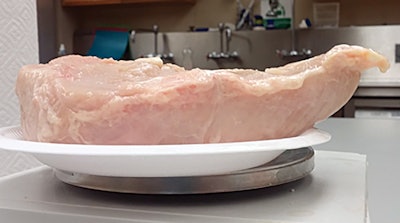
New insights revealed into syndrome that causes major losses for the broiler industry worldwide.
Both a short- and a long-term solution to wooden breast syndrome in broilers may have come a step closer thanks to research conducted at the University of Delaware in the U.S.. The study’s findings may also have implications for human health.
Wooden breast syndrome first came to the public’s attention some 10 years ago, although studies have found its existence in broilers since the 1950s. Its causes, and hence a solution to the problem have remained elusive.
However, Delaware’s studies have found that an enzyme crucial for fat metabolism -- lipoprotein lipase -- may be contributing to the syndrome, suggesting that feed additives and supplements may offer growers a solution and, longer term, the study may offer genetics companies a new point of reference.
The research team was led by Behman Abasht, animal and food sciences associate professor at the university’s College of Agriculture and Natural Resources, who has been researching wooden breast syndrome for almost a decade. In previous work, his team analyzed the genes involved in the disease, identifying biomarkers, and also characterizing the unique biochemistry of the hardened breast tissue.
Pinpointing the source
In this latest work, Abasht’s team noticed that in chickens with the syndrome, the expression of lipoprotein lipase was higher, leading to fat accumulating in the breast muscles.
Lipoprotein lipase acts as a metabolic gatekeeper, regulating how much fat is allowed in a given tissue. Normally, however, breast muscle fibers in chickens rely on glucose molecules for fuel and not fat molecules.
Using RNA sequencing, Abasht’s team determined which genes were being expressed in today’s fast-growing broilers and in slower-growing birds. They then used RNA in situ hybridization to determine exactly where this gene expression occurred inside the muscle.
Evidence was found of lipoprotein lipase being expressed in endothelial cells in chickens, which was previously unknown. Present in all blood vessels, endothelial cells serve as a barrier between the blood and surrounding tissue.
Abasht hypothesized that when more fat is oxidized for energy in breast muscle, it may lead to the excessive release of free radical molecules that would modify the muscle’s fats and proteins, leading to immune system activation to resolve the problem.
Additionally, the researchers compared this data with gene expression signals found in two commercial broiler lines, at three weeks of age and again at market age. They found that young chickens may be showing the same changes as older birds with wooden breast syndrome, but before the syndrome is detectable.
The researchers also reported finding common features between wooden breast syndrome in chickens and diabetes complications in humans, specifically diabetic cardiomyopathy.
















